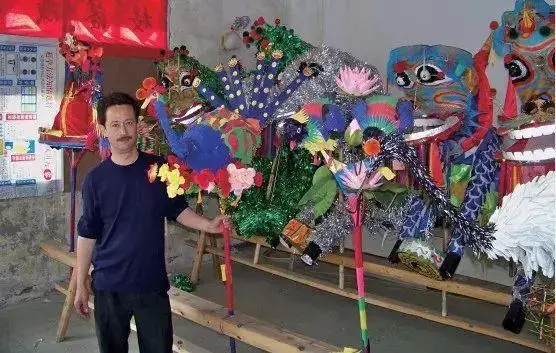In the town of Tuankou, located in the southwest of Lin’an City, Hangzhou, a ancient and mysterious art form has been passed down to this day, known as the Divine Beast Lantern. This is a familial ritualistic lantern dance, renowned for its unique style and profound cultural significance, attracting countless admirers. Situated at the border of Chun’an and Tonglu counties, Tuankou Town boasts a prime geographical location and rich cultural heritage, providing favorable conditions for the inheritance and development of the Divine Beast Lantern.
Historical Development of the Divine Beast Lantern
The history of the Divine Beast Lantern can be traced back to the distant Song Dynasty. According to records in the “Tangchang Zhou Clan Genealogy,” Emperor Zhenzong of Song Dynasty bestowed upon the eminent Confucian scholar Zhou Dunyi twelve exquisite lanterns in recognition of his outstanding contributions. Zhou Dunyi, one of the Five Elders of the Northern Song Dynasty, was the founding father of Neo-Confucianism in the Song Dynasty, a literary and philosophical figure whose work “Explanation of the Diagram of the Supreme Ultimate” had a profound influence on later generations. He integrated the twelve lanterns with the concept of Taiji, based on the principles of the Two Principles, Four Symbols, Eight Trigrams, and Sixty-Four Hexagrams, creating the performance routine of the Divine Beast Lantern. Since then, the Divine Beast Lantern has been passed down through generations of the Zhou family, becoming a familial tradition that has endured over time.

As time passed, the Divine Beast Lantern gradually spread and incorporated more local characteristics. By the year 1840, members of the Zhou clan from Anhui brought this art form to Tuankou, Lin’an, where it flourished and expanded.
Stylistic Features of the Divine Beast Lantern
The Divine Beast Lantern is renowned for its unique style and profound connotations. Every five to ten years, the Divine Beast Lantern parade traverses the countryside, becoming a splendid spectacle. During the lighting and extinguishing of the lanterns, elaborate sacrificial ceremonies are held to express reverence for the gods of heaven and earth and to commemorate the ancestors of the family.
During the lighting ceremony, offerings are made to heaven and earth, various deities are invoked, and homage is paid to the Old Wolf (the ancestral deity of bamboo carpenters in folklore), praying for the blessings of the gods to ensure the family’s peace and a bountiful harvest. Accompanied by the sound of drums, a grand procession composed of twelve divine beast lanterns and twelve floral lanterns begins its performance in open spaces such as courtyards and yards. Performers, each holding a lantern, enter the scene in a predetermined order, dancing and changing formations. These formations embody profound cultural connotations and philosophical ideas, such as the Four Gates symbolizing the cyclical nature of the four seasons and all living things; the Scissors and Forks representing the interaction of yin and yang, the perpetuation of life; the Four Corners Rotation representing the protection of the family by deities from all directions; the Twin Lions competing for a ball symbolizing bravery and strength; the Divine Beast Embracing the Hall symbolizing family unity and prosperity; the Twisted Iron Cable representing the close connection between family members; the Seahorse Sweeping the Stage symbolizing the removal of all obstacles and evil; King Wen Pushing the Cart symbolizing wisdom and civilization; the Twisting Pillar representing the family’s mainstay; and Biting the Treasure symbolizing wealth and auspiciousness.
During the extinguishing ceremony (on the 18th day of the lunar month), another sacrificial ritual is held, during which the lanterns are burned to drive away evil spirits and pray for peace and prosperity in the countryside. This process is filled with mystery and solemnity, allowing people to deeply experience the power of family beliefs and the importance of cultural heritage.
Current Status of the Inheritance of the Divine Beast Lantern
Despite its profound cultural connotations and historical value, the current status of the inheritance of the Divine Beast Lantern is not optimistic. Due to its familial inheritance mode, the inheritance scope is relatively narrow, and many techniques and performance routines are facing the risk of being lost. Especially during the social upheavals of the 1960s and 1970s, the Divine Beast Lantern was extinguished for many years, and many old artists passed away, putting this precious cultural heritage at risk.
However, it is fortunate that in recent years, with the increasing attention and support from the national and local governments for the protection of intangible cultural heritage, the Divine Beast Lantern has received more and more attention and assistance. Some enlightened individuals have also begun to focus on the excavation, organization, and protection of the Divine Beast Lantern, hoping to let more people understand and appreciate this unique art form. They conduct field investigations in rural areas, collect and organize relevant materials and oral histories; organize training sessions and seminars, inviting elder artists to pass on their skills and experiences; and actively participate in various cultural exchange and exhibition activities, allowing the Divine Beast Lantern to reach a broader audience.
Conclusion
As a unique familial ritualistic lantern dance, the Divine Beast Lantern not only carries rich historical and cultural information but also embodies the profound heritage of ancient family customs, family culture, and family beliefs. It is an important part of Chinese traditional culture and a treasure of our national spirit. Faced with the rapid development of modern society and the impact of cultural diversification, we should cherish and protect these endangered intangible cultural heritages, allowing them to flourish with new vitality in the context of the new era.